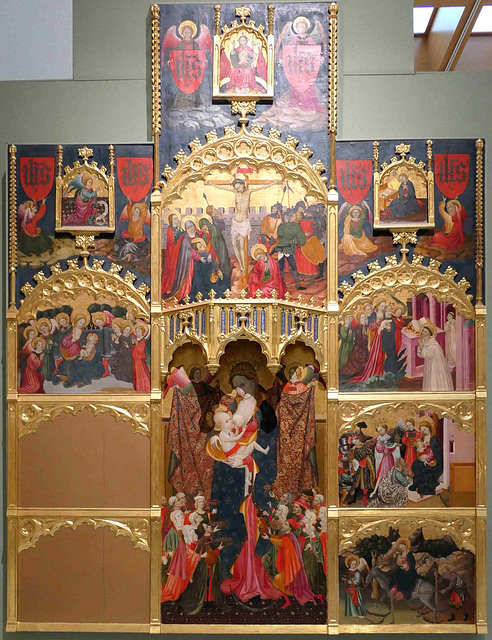Valencia - Museo de Bellas Artes
Benidorm
Benidorm
Cartagena - Churrería-Alameda
Cartagena - Calle Mayor
Cartagena - Palacio Consistorial
Cartagena - Roman theatre
Cartagena - Roman theatre
Cartagena - Museo del Teatro Romano
Cartagena - Museo del Teatro Romano
Cartagena - Museo del Teatro Romano
Orchard of Europe
Aguadulce - La Envia
Almería - Super 8 Club
Almería - Catedral de Almería
Almería - Catedral de Almería
Almería - Catedral de Almería
Almería - Plaza de la Constitución
Almería - Cable Inglés
Almería - Alcazaba
Sierra Nevada
Olive trees
Úbeda - Sacra Capilla del Salvador
Valencia - Museo de Bellas Artes
Valencia - Museo de Bellas Artes
Valencia - Museo de Bellas Artes
Valencia - Museo de Bellas Artes
Valencia - Museo de Bellas Artes
Valencia - Museo de Bellas Artes
Valencia - Museo de Bellas Artes
Valencia - Lonja de la Seda
Valencia - Lonja de la Seda
Valencia - Lonja de la Seda
Valencia - Lonja de la Seda
Valencia - Lonja de la Seda
Valencia - Lonja de la Seda
Valencia - Lonja de la Seda
Valencia - Lacolada
Valencia - Sombreria Albero
Valencia - Lookout
Valencia - Ciudad de las Artes y las Ciencias
Valencia - Ciudad de las Artes y las Ciencias
Valencia - Ciudad de las Artes y las Ciencias
Valencia - Palacio del Marqués de Dos Aguas
Valencia - Catedral de Santa María
Location
See also...
Keywords
Authorizations, license
-
Visible by: Everyone -
All rights reserved
-
24 visits
Valencia - Museo de Bellas Artes


According to the Roman historian Titus Livius "Valentia" was founded by Consul Decimus Iunius Brutus Callaicus in the 4th century BC.
A century later "Valentia Edetanorum" became one of the first Hispanic cities to become a Roman colony.
The city made rapid progress after the Arab conquest in 711, reaching 15,000 inhabitants in the Caliphate of Córdoba. The Amirids and the Dhun Nunids ruled in “Balansiya”. In 1094, El Cid, a Castilian noble, conquered the city. The conquest was not carried out on behalf of one of the Christian kingdoms, but on the Cid's own account, who proclaimed himself "Señor de Valencia" and thus created a kind of private kingdom. He was able to defend the city against several Almoravid attacks, and after his death in 1099, his widow Jimena managed to hold Valencia until 1102, when it fell to the Almoravids, and a little later to the Almohads.
After the victory of the united Christian armies over the Almohads in the Battle of Las Navas de Tolosa (1212), Moorish Spain fell apart again into individual small kingdoms, including a Taifa from Valencia.
It was finally conquered in 1238 by Jaime I de Aragón (aka "el Conquistador"), after a five-month siege.
In the 15th century, the city grew rapidly and developed into one of the largest Mediterranean ports and an important trade and financial center. At the beginning of the 15th century the city had around 40,000.
The "Museo de Bellas Artes" was founded in 1913 and is located in the St. Pius V Palace, built in the 17th–18th centuries.
Antoni Peres / doc in Valencia 1393- 1423 /
Altarpiece of the Life of the Virgin
A century later "Valentia Edetanorum" became one of the first Hispanic cities to become a Roman colony.
The city made rapid progress after the Arab conquest in 711, reaching 15,000 inhabitants in the Caliphate of Córdoba. The Amirids and the Dhun Nunids ruled in “Balansiya”. In 1094, El Cid, a Castilian noble, conquered the city. The conquest was not carried out on behalf of one of the Christian kingdoms, but on the Cid's own account, who proclaimed himself "Señor de Valencia" and thus created a kind of private kingdom. He was able to defend the city against several Almoravid attacks, and after his death in 1099, his widow Jimena managed to hold Valencia until 1102, when it fell to the Almoravids, and a little later to the Almohads.
After the victory of the united Christian armies over the Almohads in the Battle of Las Navas de Tolosa (1212), Moorish Spain fell apart again into individual small kingdoms, including a Taifa from Valencia.
It was finally conquered in 1238 by Jaime I de Aragón (aka "el Conquistador"), after a five-month siege.
In the 15th century, the city grew rapidly and developed into one of the largest Mediterranean ports and an important trade and financial center. At the beginning of the 15th century the city had around 40,000.
The "Museo de Bellas Artes" was founded in 1913 and is located in the St. Pius V Palace, built in the 17th–18th centuries.
Antoni Peres / doc in Valencia 1393- 1423 /
Altarpiece of the Life of the Virgin
kiiti, Alexander Prolygin have particularly liked this photo
- Keyboard shortcuts:
Jump to top
RSS feed- Latest comments - Subscribe to the comment feeds of this photo
- ipernity © 2007-2024
- Help & Contact
|
Club news
|
About ipernity
|
History |
ipernity Club & Prices |
Guide of good conduct
Donate | Group guidelines | Privacy policy | Terms of use | Statutes | In memoria -
Facebook
Twitter

Sign-in to write a comment.